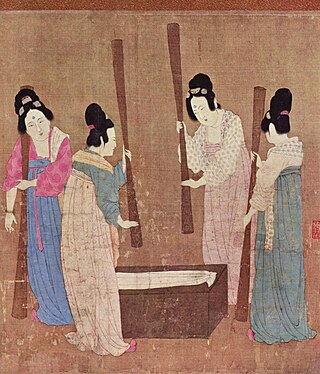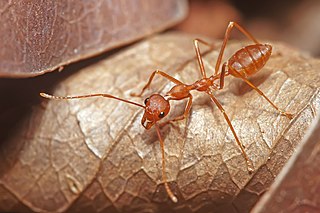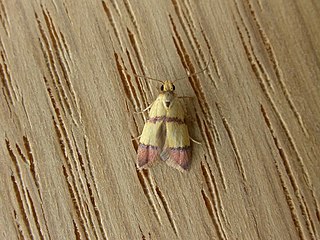
Ailanthus is a genus of trees belonging to the family Simaroubaceae, in the order Sapindales. The genus is native from east Asia south to northern Australasia.

The domestic silk moth is an insect from the moth family Bombycidae. It is the closest relative of Bombyx mandarina, the wild silk moth. The silkworm is the larva of a silk moth. The silkworm is of particular economic value, being a primary producer of silk. A silkworm's preferred food is white mulberry leaves, though they may eat other species of mulberry, and even leaves of other plants like the osage orange. Domestic silk moths are entirely dependent on humans for reproduction, as a result of millennia of selective breeding. Wild silk moths are not as commercially viable in the production of silk.

The luna moth, also called the American moon moth, is a Nearctic moth in the family Saturniidae, subfamily Saturniinae, a group commonly named the giant silk moths.

Sericulture, or silk farming, is the cultivation of silkworms to produce silk. Although there are several commercial species of silkworms, the caterpillar of the domestic silkmoth is the most widely used and intensively studied silkworm. Silk was believed to have first been produced in China as early as the Neolithic period. Sericulture has become an important cottage industry in countries such as Brazil, China, France, India, Italy, Japan, Korea, and Russia. Today, China and India are the two main producers, with more than 60% of the world's annual production.

Samia cynthia, the ailanthus silkmoth, is a saturniid moth, used to produce silk fabric but not as domesticated as the silkworm, Bombyx mori. The moth has very large wings of 113–125 mm (4.4–4.9 in), with a quarter-moon shaped spot on both the upper and lower wings, whitish and yellow stripes and brown background. There are eyespots on the outer forewings. The species was first described by Dru Drury in 1773.

Oecophylla smaragdina is a species of arboreal ant found in tropical Asia and Australia. These ants form colonies with multiple nests in trees, each nest being made of leaves stitched together using the silk produced by the ant larvae: hence the name 'oecophylla' [Greek for 'leaf-house'].

The Limacodidae or Eucleidae are a family of moths in the superfamily Zygaenoidea or the Cossoidea; the placement is in dispute. They are often called slug moths because their caterpillars bear a distinct resemblance to slugs. They are also called cup moths because of the shape of their cocoons.

Papilio aegeus, the orchard swallowtail butterfly or large citrus butterfly is a species of butterfly from the family Papilionidae, that is found in eastern Australia and Papua New Guinea.

Nomophila noctuella, the rush veneer, is a species of moth of the family Crambidae.

Ironopolia sobriella is a moth of the family Oecophoridae. It is found in Australia, where it has been recorded from Queensland, New South Wales, the Australian Capital Territory, Victoria, South Australia and Western Australia. The species was described by Francis Walker in 1863.

Platyptilia omissalis is a moth of the family Pterophoridae. The species was described by Thomas Bainbrigge Fletcher in 1926. It is found in Australia from southern Queensland to Victoria, south-western Australia and Tasmania.

Nomophila is a genus of moths of the family Crambidae.

Tussar silk is produced from larvae of several species of silkworms belonging to the moth genus Antheraea, including A. assamensis, A. paphia, A. pernyi, A. roylei, and A. yamamai. These silkworms live in the wild forests in trees belonging to Terminalia species and Shorea robusta, as well as other food plants such as jamun and oak found in South Asia, eating the leaves of the trees on which they live. Tussar silk is valued for its rich texture and natural, deep-gold colour, and varieties are produced in many countries, including China, India, Japan, and Sri Lanka.

Dispar compacta, the dispar skipper or barred skipper, is a butterfly of the family Hesperiidae. It is found in the Australian Capital Territory, New South Wales, Queensland, South Australia and Victoria.

Heteroteucha distephana is a moth of the family Oecophoridae. It is found in Australia, in the states of New South Wales, Queensland and Victoria.

Heortia vitessoides is a moth of the family Crambidae described by Frederic Moore in 1885. It is found in south-east Asia, including Fiji, Hong Kong, India, Taiwan, Thailand and northern Queensland in Australia.

Parotis marginata is a species of moth of the family Crambidae. It is known from south-east Asia, including India, Bangladesh and China, as well as Fiji, Japan and Australia, where it is known from the Northern Territory and Queensland.

Pararguda rufescens is a moth of the family Lasiocampidae. It is known from Australia, including New South Wales, Queensland, South Australia, Tasmania, Victoria and Western Australia.

Nomophila nearctica, the lucerne moth, clover nomophila, false webworm, celery stalkworm or American celery webworm, is a moth of the family Crambidae. It is known from southern Canada and all of the United States, south to Mexico and the Neotropics.




















